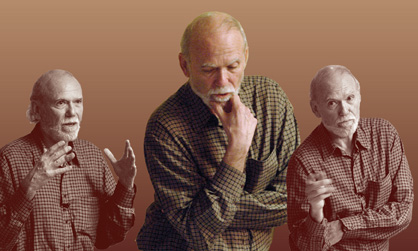Virtual Structure
 Photos: Diana Rogers, SLAC |
Barish models International Linear Collider team on worldwide experiment collaborations.
by Mike Perricone
As the newly-appointed Director of the Global Design Effort (GDE) for the proposed International Linear Collider (ILC), Barry Barish will lead teams of scientists worldwide in the research and development projects advancing the design of the next-generation discovery machine in high-energy physics. But in doing so, no one will have to change addresses.
Barish will soon be extending invitations to join the GDE's Central Management Team. The team will consist of an anticipated 15-20 FTEs (full-time equivalents) drawn from a total staff of perhaps twice that number--all working from their home laboratories. The GDE will be modeled on the experiment collaboration approach, with its work spread across the three regions forming the basic ILC infrastructure: Asia, Europe and North America. Barish wants the best people, not just the best people who are willing to relocate.
"I am collecting suggestions from the community, from the ILCSC [ILC Steering Committee], from the laboratory directors," he says. "I am planning to use that to form the core group for the GDE and then to round it out with other members with the missing skill needs. The talent in HEP is spread across the globe, and we must provide access and ways to enable participation for scientists from all countries."
Barish chaired the ILC International Technology Recommendation Panel (ITRP), which recommended superconducting radiofrequency technology as the basis of the collider's main linear accelerator design. That recommendation was endorsed by the International Committee for Future Accelerators (ICFA) at a meeting in Beijing in August, 2004. The GDE appointment came on March 18, 2005, during the Linear Collider Workshop at Stanford University. The choice was announced by Jonathan Dorfan, Director of Stanford Linear Accelerator Center (SLAC) and chair of ICFA. Dorfan described Barish as "one of the most respected personalities in particle physics."
Barish immediately made communication a top priority. "As one moves further from persons working in this area of physics," he said, "I believe we still have a big challenge to convince our colleagues of the science case and that this machine should be built. The science arguments must be honed and the design and plan must be understood so that it can become a common goal to fit this new facility into the long range program for high-energy physics. I believe that the communications must involve a very proactive effort to provide information, keep the communities and policy makers informed, and make our case. This must be done on a scale beyond what we are accustomed to in HEP."
|
Global reach of ILC shows early results "There have already been two significant accomplishments as an international body," says Michael Witherell, Director of Fermilab and member of the US Linear Collider Steering Group. "The main success was the appointment of the International Technology Recommendation Panel, which Barry Barish chaired. The second and most recent is the selection of Barry Barish to direct the Global Design Effort. The search committee was international in its makeup, and its recommendation was endorsed by the International Linear Collider Steering Committee." The key Linear Collider groups and their current chairs International Linear Collider Steering Committee (ILCSC) US Linear Collider Steering Group (USLCSG) Asian Committee for Future Accelerators (ACFA) European Committee for Future Accelerators (ECFA) |
The next steps in R&D, in Barish's plan, involve agreeing on a baseline configuration for the ILC. The first efforts will take place at the ILC Snowmass (Colorado) conference in August and at follow-up meetings, with the goal of developing a Conceptual Design Report (CDR) before the end of 2005. Barish also hopes to define a small set of candidate ILC sample sites in the three regions during that time, enabling site-dependent designs for the CDR--which he wants produced by the end of 2006. Barish sees the longer-range R&D guided first by the CDR, and then by the Technical Design Report, which would come out 2-3 years later. There will also be a well-defined R&D program on alternatives in design that could improve cost and performance, as well as R&D on the process of building the machine, stressing the importance of technology transfer to industry.
In taking on the GDE role, Barish is resigning his position at Caltech, where he is Linde Professor of Physics and director of the Laser Interferometer Gravitational Wave Observatory (LIGO). He will report to the ILCSC, with his salary supported through the Department of Energy, the same arrangement for other American scientists joining the team. His experiences on several US and international advisory committees tell Barish there is broad support for the Linear Collider within the particle physics field. They also tell him there are concerns about costs, and about the impact on the rest of the field and on other areas of the physical sciences. As a result, Barish sees the need for a "delicate balancing act over the next few years:" first, finding a robust and affordable design, without unduly affecting the rest of the field; then redirecting the program to accommodate building that machine.
It's a challenge, but Barish says he sees the resources to meet it. "Clearly, there is a lot to do," he says, "and I invite physicists of all persuasions and all nations to join the ILC design effort."
Click here to download the pdf version of this article.






